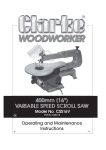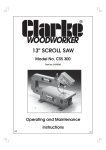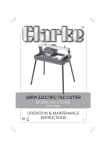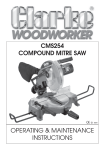Download Clarke CMS 200 Specifications
Transcript
0401 PLEASE READ THIS MANUAL THOROUGHLY BEFORE USE. If you have any problems using, or setting up this machine, ring this number...020 8988 7400 • Press 1 for Parts • Press 2 for Technical Assistance WARNING! Due to the gearing arrangement, this machine generates considerable noise. Do not be alarmed as this is quite normal for this type of machine. We strongly recommend that you wear ear defenders during use. PARTS & SERVICING For Parts & Servicing, please contact your nearest dealer, or CLARKE International, on one of the following numbers. PARTS & SERVICE TEL: 020 8988 7400 PARTS & SERVICE FAX: 020 8558 3622 or e-mail as follows: PARTS: [email protected] SERVICE: [email protected] 2 Thank you for purchasing this CLARKE 8 inch Compound Mitre Saw which is designed for DIY/Hobby use only. Before operating the Mitre Saw please read this leaflet thoroughly and carefully follow all instructions. This will ensure the safety of yourself and that of others around you, and you can also look forward to the machine giving you long and satisfactory service. GUARANTEE This CLARKE product is guaranteed against faulty manufacture for a period of 12 months from the date of purchase. Please keep your receipt as proof of purchase. This guarantee is invalid if the product is found to have been abused or tampered with in any way, or not used for the purpose for which it was intended. Faulty goods should be returned to their place of purchase, no product can be returned to us without prior permission. This guarantee does not effect your statutory rights. CONTENTS Page Safety Precautions ............................................................... 4 Additional Precautions for Mitre Saws ............................... 6 Electrical Connections ......................................................... 7 Principle Parts ........................................................................ 8 Features ................................................................................. 9 Assembly .............................................................................. 10 Operation ...... Cross Cutting ............................................. 10 Mitre Cutting ............................................. 11 Bevel Cutting ............................................ 12 Compound Mitre Cutting ........................ 12 Maintenance ...................................................................... 13 Blade renewal........................................... 13 Adjustments ......................................................................... 15 Specifications ...................................................................... 15 Maximum Cutting Sizes ...................................................... 15 Parts Lists and Diagrams ............................................. 16 - 17 3 SAFETY PRECAUTIONS GENERAL SAFETY RULES FOR OPERATING MACHINERY WARNING: As with all machinery, there are certain hazards involved with their operation and use. Exercising respect and caution will considerably lessen the risk of personal injury. However, if normal safety precautions are overlooked or ignored, personal injury to the operator or damage to property, may result. 1. READ and BECOME FAMILIAR with the entire operating manual. Learn the machines’ applications and limitations as well as the specific potential hazards peculiar to it. 2. EARTH ALL MACHINES. If the machine is equipped with three-pin plug, it should be plugged into a three-pin electrical socket. Never remove the earth pin. 3. ALWAYS ensure that ADEQUATE LIGHTING is available. A minimum intensity of 300 lux should be provided. Ensure that lighting is placed so that you will not be working in your own shadow. 4. CHECK for DAMAGE. Before using the machine, any damaged part, such as a guard etc., should be checked to ensure that it will operate properly, and perform its intended function. Check for alignment of moving parts, breakage of parts, mountings, and any other condition that may affect the machines’ operation. Any damage should be properly repaired or the part replaced. If in doubt, DO NOT USE the machine. Consult your local dealer. 5. DISCONNECT the MACHINE from the power supply before servicing and when changing accessories such as blades, etc. 6. KEEP GUARDS in place and in working order. 7. ALWAYS WEAR SAFETY GOGGLES, manufactured to the latest European Safety Standards. Also use a face or dust mask if the cutting operation is dusty. Everyday eyeglasses do not have impact resistant lenses, they are NOT safety glasses. 8. KEEP WORK AREA CLEAN. Cluttered areas and benches invite accidents. 9. ALWAYS WEAR EAR PROTECTORS/DEFENDERS. 10. DON’T FORCE the machine. It will do a better and safer job at the rate for which it was designed. 4 11. REMOVE ADJUSTING KEYS AND WRENCHES. Form the habit of checking to see that keys and adjusting wrenches are removed from the machine before switching on. 12. DRUGS, ALCOHOL, MEDICATION. Do not operate machine while under the influence of drugs, alcohol or any medication. 13. USE RECOMMENDED ACCESSORIES. The use of improper accessories could be hazardous. 14. NEVER LEAVE MACHINE RUNNING UNATTENDED. Turn power OFF. Do not leave machine until it comes to a complete stop. 15. ALWAYS REMOVE PLUG from electrical outlet when adjusting, changing parts, or working on machine. 16. AVOID DANGEROUS ENVIRONMENT. Don’t use power machines in damp or wet locations or expose them to rain. Keep your work area well illuminated. DO NOT USE in explosive atmosphere (around paint, flammable liquids etc.). 17. KEEP CHILDREN AWAY. All visitors should be kept a safe distance from the work area, especially whilst operating the unit. 19. MAINTAIN MACHINE IN TOP CONDITION. Keep tools sharp and clean for the best and safest performance. Follow maintenance instructions. 21. DON’T OVERREACH. Keep your proper footing and balance at all times. For best footing, wear rubber soled footwear. Keep floor clear of oil, scrap wood, etc. 22. WEAR PROPER APPAREL. Loose clothing or jewelry may get caught in moving parts. Wear protective hair covering to contain long hair. 23. MAKE WORKSHOP CHILDPROOF. Cover the saw adequately when not in use, to prevent children from damaging themselves by tampering with it. 24. NEVER STAND ON THE MACHINE. Serious injury could occur if the machine is tipped or if a cutting tool is accidentally contacted. Do not store materials above or near a machine, such that it is necessary to stand on the machine to reach them. 25. HANDLE WITH EXTREME CARE Whenever transporting or installing machinery, and always use a lifting tool. 26. AVOID ACCIDENTAL STARTING. Ensure the switch is OFF before plugging in to mains. 27. BE AWARE that accidents are caused by carelessness due to familiarity. ALWAYS concentrate on the job in hand, no matter how trivial it may seem. 5 ADDITIONAL SAFETY INSTRUCTIONS for MITRE SAWS 1. Wear safety goggles as protection against flying wood chips and saw dust. In many cases, a full face shield is even better protection. A dust mask is also recommended to keep saw dust out of your lungs. 2. Use a solid wood workbench which will not move under load. 3. This saw is for indoor, domestic use only. 4. Clear the work table of all objects except the workpiece (tools, scraps, rulers etc.) before switching on the saw. 5. Keep your fingers well away from the blade. 6. Switch off the saw, and make sure the blade has come to a complete stop before clearing sawdust or off-cuts from the table. 7. Make sure there are no nails or foreign objects in the part of the workpiece to be sawn. 8. Set up the machine and make all adjustments with the power OFF, and disconnected from the supply. 9. DO NOT operate the machine with the guards removed. They must all be in place and securely fastened when performing any operation 10. Use ONLY approved replacement saw blades. Contact your local CLARKE dealer for advice. The use of inferior blades may increase the risk of injury. 11. DO NOT saw any material that does not have a flat surface on which to bear. 12. This machine is designed for cutting wood. DO NOT use for cutting metal, plastics or masonry. 13. Do Not force the blade, lower it gently into the work. 14. Ensure you have complete control of the Cutting Head at all times. When a cut is completed, return it to its uppermost position gently. DO NOT allow it to snap back heavily under spring pressure. 15. Always clamp the work to the table...DO NOT perform freehand operations. 16. Ensure that the portion of the workpiece being cut bears firmly against the back fence. 17. Provide adequate support for long workpieces. 18. Never use solvents for cleaning plastic parts as this could cause damage to the material. A soft damp cloth only is required. 6 ELECTRICAL CONNECTIONS Connect the mains lead to a standard, 230 Volt (50Hz) electrical supply through an approved 13 amp BS 1363 plug, or a suitably fused isolator switch. WARNING! THIS APPLIANCE IS DOUBLE INSULATED IMPORTANT: The wires in the mains lead are coloured in accordance with the following code: Blue - Neutral Brown - Live As the colours of the flexible lead of this appliance may not correspond with the coloured markings identifying terminals in your plug proceed as follows: Connect BROWN cord to terminal marked with “L” or coloured RED. Connect BLUE cord to the terminal marked with “N” or coloured BLACK. If this appliance is fitted with a plug which is moulded onto the electric cable (i.e. non-rewirable) please note: 1. The plug must be thrown away if it is cut from the electric cable. There is a danger of electric shock if it is subsequently inserted into a socket outlet. 2. Never use the plug without the fuse cover fitted. 3. Should you wish to replace a detachable fuse carrier, ensure that the correct replacement is used (as indicated by marking or colour code). 4. Replacement fuse covers can be obtained from your local dealer or most electrical stockists. Fuse Rating The fuse in the plug must be replaced with one of the same rating -13amps and this replacement must be ASTA approved to BS1362. Cable Extension If a cable extension is needed, it is essential to ensure that the size of the conductors is at least the same size as those of the power cable supplied. 7 PRINCIPAL PARTS OF THE SAW Fig.1 Fig.2 8 FEATURES (Ref. Fig. 3) As its’ name implies, the machine is a Bevel/Mitre Saw, capable of straight cross cutting, and cutting bevels and mitres, or a combination of the two. The main arm, or Cutting Head, carries the motor and the tungsten carbide saw blade. It is allowed to swivel to produce mitre cuts and tilt to the left to produce bevel cuts. The maximum sizes of wood that may be cut in any of these processes is given under Specifications on page 15. A dust extraction outlet (E) is provided at the rear of the machine. If required it can be connected to a vacuum cleaner which will provide fast and efficient removal of sawdust. The vacuum cleaner may be used continuously or intermittently depending upon your requirements. Saw blades with a bore of 18mm or 20mm may be used. This saw is not designed for cutting metal, plastics or masonry. Fig.3 9 ASSEMBLY and INSTALLATION. Ref: Fig. 3 The saw is fully assembled and adjusted at the factory. On receipt inspect the machine to ensure that all parts are accounted for and that no damage was incurred during transit. Loose items are: 1x Peg spanner, and 1x Box spanner Any deficiency or damage should be reported to your CLARKE dealer immediately. Mount the machine on a firm solid base that will not move under load. Ensure there is an appropriate electrical supply, and adequate lighting, so that you will not be working in your own shadow. Four holes are provided, one at each corner of the base, so that the machine may be bolted permanently to a workbench for added stability, using 8mm bolts (not provided). Alternatively it may be bolted to a piece of plywood with a thickness of 16mm (5/8”). The Cutting Head is locked in its lower position for transit purposes. To release it, pull out the Head Locking Knob (B), (It may be necessary to apply slight downward pressure to the head in order to do so), and allow the head to rise to its upper position gently, under control. The head will lock in its upper position, and is prevented from being lowered until the Head Release Button (A) is pressed OPERATION. (Ref Fig.4) A. Cross Cutting. (at 90°) First, set the work in place with one end firmly clamped against the table and back fence. It is important to ensure that one end of the workpiece is completely free to move i.e. NOT clamped or held in any way. This will normally be the offcut or shorter end. NOTE: If the workpiece is not entirely straight, ensure that the portion at either side of the intended cut rests firmly against the table and back fence. When satisfied, make a final check to ensure that all safety precautions are being complied with, then pull and hold the starter switch (G, Fig.1), and allow the blade to reach full speed. If any unusual sounds or vibrations occur, release the starter switch immediately and investigate the cause. 10 When satisfied, press the Head Release Button (A), and gently lower the head so that the blade makes contact with the workpiece. Do not force the blade, a light pressure is all that is required. Fig.4 You will notice that to provide maximum safety, the blade is not exposed at any time, and the guard rises automatically as the blade is lowered. Nevertheless, NEVER treat the machine with indifference, and NEVER be casual with your approach. To switch off, release the starter switch whilst still maintaining full control of the head. NEVER allow the head to spring upwards - always maintain control. Wait for the blade to stop completely before removing the workpiece, off-cuts etc. B. Mitre Cutting This is a cross cutting operation, except that the saw blade is set at an angle to the work, but remains perpendicular to the table. This is achieved by mounting the complete Head assembly on a table Fig.5 which is free to rotate by up to 45° . To set the required mitre angle unscrew the table securing screws (H, fig.5), and rotate the table, with the head and saw blade, to the desired position, lining up the angle on the scale with the mark on the edge of the table (J, fig.5). Lock the table in position with the locking screws (H). The procedure for cutting is the same as that for cross cutting. 11 C. Straight Bevel Cutting As with Mitre Cutting, this is a cross cutting operation, except that the blade is not perpendicular to the table, (see fig. 6). Ensure the table is set so that the Fig.6 mark (J), on the edge of the table, lines up with the zero on the scale on the bed. The 45° adjuster is factory set so that when the Head is tilted to its fullest extent the blade will cut a perfect 45° bevel. If however you require any other angle, you should proceed as follows: Cut a mitre of the required angle, on a spare piece of wood, and use this as a template for your bevel cut. Fig.7 Slacken off the Bevel Locking Nut (C, fig.7), using the box spanner provided, and swing the Head to the side. Lower the arm, and bring your template up to the saw blade. When satisfied that the edge of template and blade are parallel, lock the head in position with lock nut (C). Your angle is now set. The procedure for cutting is the same as that for cross cutting....press start switch G, wait for full speed to develop, then lower the blade to the workpiece. D. Compound Mitre and Bevel Cutting. Having determined the angles you require, firstly set the bevel angle, using the procedure described above, and then the mitre angle. NOTE: Compound mitre and bevel cuts, at a full 45°, can only be made when the head is turned to the left. The procedure for cutting is the same as that for cross cutting. 12 MAINTENANCE 1. General The machine is maintenance free, except for changing the saw blade when necessary, maintaining adjustments, and ensuring that after use, you clean away any sawdust or wood chips, with a low pressure air line or brush, paying particular attention to the motor air vents which should be kept clear at all times. Should the motor not function normally, it is possible that it has become clogged with saw dust, in which case, it will be necessary to disassemble the motor in order to clean the various components. Contact your CLARKE dealer for advice. 2. Changing the Saw Blade IMPORTANT: Exercise extreme care when handling the saw blade. The tips are extremely sharp, and careless handling could result in severe personal injury. 1. With the machine disconnected from the mains supply, and the cutting head in the raised position, slacken off the blade securing bolt. This is achieved by holding the outer flange steady with the peg spanner provided, whilst turning the securing bolt (see fig. 8), CLOCKWISE. The bolt has a LEFT HAND THREAD. Do not remove the bolt completely. Fig.8 Fig.9 13 2. Remove the four bolts shown at F, Fig.9, and remove the Upper Blade Guard Cover. 3. With the cover removed, unscrew the blade securing bolt, with its washer, completely. Pull off the outer flange, and then the blade. (Take great care when handling the blade). You should take this opportunity to clean the inside of the blade guard of any dust build-up and check generally for security of parts. NOTE: This machine is capable of accepting blades with bores of 18 and 20mm. Fig.10 4. Check the bore of your replacement blade. If it is the same as the blade you are replacing, simply mount it on to the boss of the inner flange shown in fig. 10, with the blade tips facing down at the front. Ensure the parts are perfectly clean, and the blade sits snugly on the boss. 5. Replace the outer flange followed by the securing bolt with washer - remembering the bolt has a left hand thread. Leave the bolt finger tight. 6. Replace the upper blade guard cover and securing bolts (F). Tighten the bolts, but do not overtighten them as this could strip the threads NOTE: If you are replacing a 18mm bore blade with an 20mm bore blade, or vice versa, it will be necessary to pull off the inner flange from the motor shaft, turn it through 180° and then replace it. The correct boss will now face outwards allowing you to properly mount the new blade. 7. With the upper blade guard cover secure, tighten the blade securing bolt using the peg and socket spanners and provided. Do not overtighten and DO NOT use extensions to the socket spanner lever. NOTE: The use of HSS blades is NOT recommended. 14 ADJUSTMENTS If you find that the cross cut is not entirely square, it will be necessary to adjust the head using the 90° adjuster screw shown in Fig. 2 on page 8. To do this, place a small square on the table. Lower the arm, and bring the square up to the blade to test for accuracy. Should any adjustment be required, slacken off the Bevel Locking Nut and the 90° adjuster screw securing nut, then screw the adjuster accordingly whilst holding the head firmly against the stop. Tighten the securing nut when the head is exactly perpendicular. Similarly should the 45° stop require adjusting, use a 45° template up against the saw blade to set the adjuster to the correct position. SPECIFICATIONS Motor: .................................................. Running Current ....................... Power Rating: ........................... Speed: ...................................... Fuse Rating ........................................... Dimensions: (Head Lowered) ............. Dimensions: (Head Raised) ................ Blade size: (Fitted) ............................... Noise level ........................................... Vibration Level ..................................... Gross weight ....................................... Part Number ......................................... 230V 50Hz 1 phase. 5Amps 800 Watts 4500RPM 13Amps 365x345x270mm 365x345x410mm 205mm 40T 18mm Bore 109.7dB at 1M 22.2m/s² (Normal Load) 7.2kg 6500755 Maximum Cutting Sizes Type of Cut Depth Thickness Cross (90°) 50mm 100mm Mitre (at 45°) 50mm 70mm Bevel (at 45°) 35mm 100mm Compound (at 2x 45°) 35mm 70mm Please note that the details and specifications contained herein, are correct at the time of going to print. However, CLARKE International reserve the right to change specifications at any time without prior notice. Always consult the machine’s data plate 15 PARTS DIAGRAM 16 PARTS LIST No. Description 1 2 3 4 5 6 7 8 9 10 11 12 13 14 15 16 17 18 19 20 21 22 23 24 25 26 27 28 29 30 31 32 33 34 35 36 37 38 39 40 41 42 43 44 44 46 Foot Clamp Base Turntable Washer Backfence Screw, M6X28 Eccentric spacer Screw, M6X16 Screw Support base Screw, fixed Nut, M8 Screw, M5X18 Nut, M5 Screw, M6X16 Roker arm Guard Screw, M5X12 Main Pivot Bolt Bracket Pressure sleeve Long nut Spring Nut, MS Guard cover Spring Positioning screw Washer Frame Washer Fixed washer Nut, Pin Washer Push rod Positioning bolt Spring Washer Cable support Screw, M5X12 Cord clamp Screw, M4X12 Bolt, M6X45 Nut, M6 Part No. HTCMS20001 HTCMS20002 HTCMS20003 HTCMS20004 HTCMS20005 HTCMS20006 HTCMS20007 HTCMS20008 HTCMS20009 HTCMS20010 HTCMS20011 HTCMS20012 HTCMS20013 HTCMS20014 HTCMS20015 HTCMS20016 HTCMS20017 HTCMS20018 HTCMS20019 HTCMS20020 HTCMS20021 HTCMS20022 HTCMS20023 HTCMS20024 HTCMS20025 HTCMS20026 HTCMS20027 HTCMS20028 HTCMS20029 HTCMS20030 HTCMS20031 HTCMS20032 HTCMS20033 HTCMS20034 HTCMS20035 HTCMS20036 HTCMS20037 HTCMS20038 HTCMS20039 HTCMS20040 HTCMS20041 HTCMS20042 HTCMS20043 HTCMS20044 HTCMS20045 HTCMS20046 17 No. Description 47 48 49 50 51 52 53 54 55 56 57 58 59 60 61 62 63 64 65 66 67 68 69 70 71 72 73 74 75 76 77 78 79 80 81 82 83 84 85 86 87 88 89 90 91 Nut, MS Bush, HK0709 Washer Key Gear Transmission shaft Ball bearing base Screw, M4X50 Ball bearing Precision washer Cover Screw, M4X8 Inner Flange Saw Blade Outer Flange Spring washer Bolt, M8X25 Ball bearing Armature Ball bearing Plate Screw, M4X58 Stator assy. Casing Brush Bush spring Brush holder Inducer Rear cover Screw, Handle LH Screw, M4X18 Capacitor Switch Nut, MS Screw, M5X11 Cable shroud Power cable Handle RH Cover Screw, M4X34 Locking knob Frame Square washer Screw, M6X12 Part No. HTCMS20047 HTCMS20048 HTCMS20049 HTCMS20050 HTCMS20051 HTCMS20052 HTCMS20053 HTCMS20054 HTCMS20055 HTCMS20056 HTCMS20057 HTCMS20058 HTCMS20059 HTCMS20060 HTCMS20061 HTCMS20062 HTCMS20063 HTCMS20064 HTCMS20065 HTCMS20066 HTCMS20067 HTCMS20068 HTCMS20069 HTCMS20070 HTCMS20071 HTCMS20072 HTCMS20073 HTCMS20074 HTCMS20075 HTCMS20076 HTCMS20077 HTCMS20078 HTCMS20079 HTCMS20080 HTCMS20081 HTCMS20082 HTCMS20083 HTCMS20084 HTCMS20085 HTCMS20086 HTCMS20087 HTCMS20088 HTCMS20089 HTCMS20090 HTCMS20091 19






















